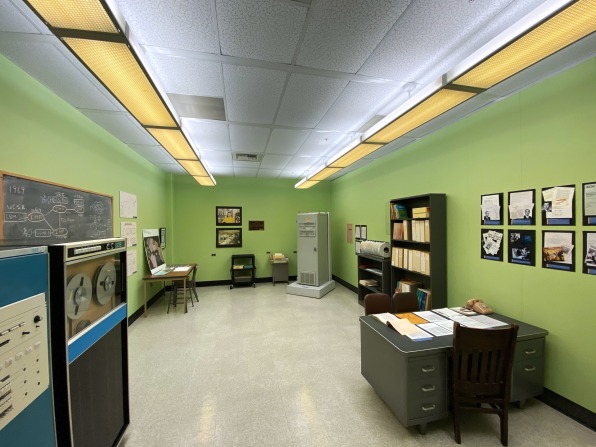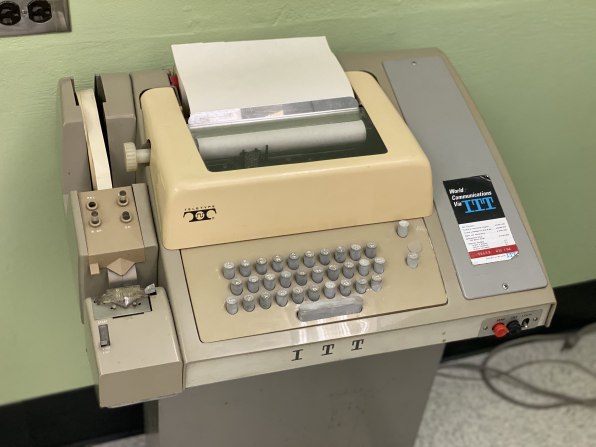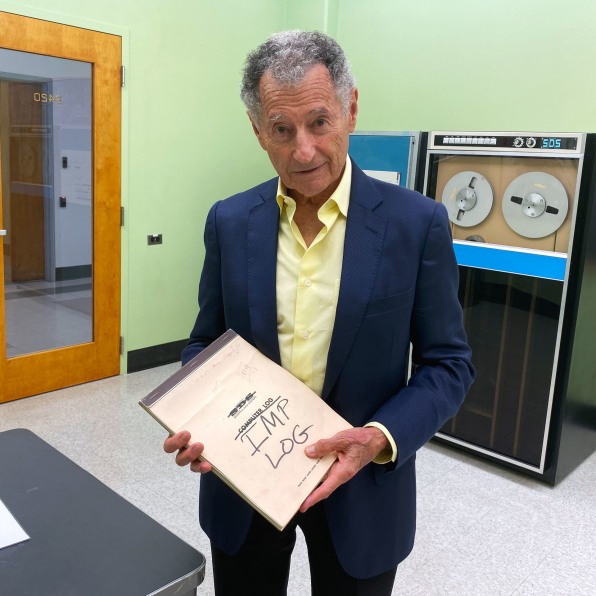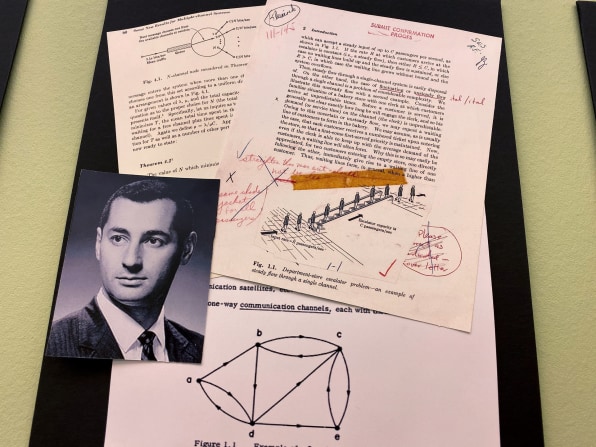This is the story of the creation of ARPANET, the revolutionary predecessor of the Internet, told by event participants

Arriving at the Bolter Hall Institute at the University of California, Los Angeles (UCLA), I climbed the stairs to the third floor in search of room 3420. And then I went into it. From the corridor, she did not seem any special.
But 50 years ago, on October 29, 1969, something monumental happened in it. Graduate student Charlie Klein, sitting at the ITT Teletype terminal, carried out the first digital data transfer for Bill Duval, a scientist sitting at another computer, who was with Stanford Research Institute (today known as SRI International), in a completely different part of California. So began the story of ARPANET , a small network of academic computers that became the forerunner of the Internet.
This is not to say that at that time this brief act of data transmission thundered to the whole world. Even Klein and Duval could not fully appreciate their achievement: “I don’t remember something special about that evening, and I definitely didn’t understand then that we did something special,” says Kline. However, their connection became evidence of the realistic concept, which ultimately provided access to almost all the information of the world for any person who owns a computer.
Today, everything from smartphones to automatic garage doors is the network nodes that came from the one that Kline and Duval checked on that day. And the story of how he determined the first rules for moving bytes around the world is worth listening to, especially when they tell it themselves.
“That there was no more”
And in 1969, many people helped Klein and Duval make that evening breakthrough on October 29th - including UCLA professor Leonard Kleinrock , with whom, apart from Klein and Duval, I talked on the 50th anniversary. Kleinrock, still working at the university, said that ARPANET was in some ways a child of the Cold War. When in October 1957, the Soviet Sputnik-1 blinked in the sky over the United States, the shock waves from it passed both through the scientific community and through the political establishment.

Room No. 3420, restored in all its splendor of the 1969 model
Sputnik’s launch “caught the United States with its pants down, and Eisenhower said:“ So there’s no more, ”Kleinrock recalled in our conversation with him in room 3420, now known as the Historical Internet Center. Kleinrock. "Therefore, in January 1958, he formed the Advanced Research Projects Agency, ARPA, as part of the Department of Defense, to support STEM, the exact sciences studied at US universities and research laboratories."
By the mid-1960s, ARPA had secured funding for the creation of large computers used by researchers from universities and think tanks around the country. ARPA's finance manager was Bob Taylor, a key figure in computer history who later led the PARC lab at Xerox. In ARPA, unfortunately, it became clear to him that all these computers speak different languages and do not know how to communicate with each other.
Taylor hated the need to use different terminals to connect to various remote research computers, each of which worked on its own dedicated line. His office was packed with teletypes.

In 1969, such Teletype terminals were an integral part of computing devices.
“I said dude, obviously what needs to be done. Instead of your three terminals, there should be one terminal that goes where you need to, ”said Taylor in an interview with the New York Times in 1999. “This idea is ARPANET.”
Taylor had more practical reasons for wanting a network. He constantly received requests from researchers from all over the country to finance the purchase of larger and faster mainframes . He knew that most of the government-funded computing power was idle, says Kleinrock. For example, a researcher could use all the capabilities of a computing system from SRIin in California to the maximum, and at the same time, the mainframe in MIT could sit idle, say, off-hours on the East Coast.
Or it could be that the mainframe in one place contained software that could be useful in other places - like, for example, the first of its kind graphical software made with ARPA money at the University of Utah. Without such a network, “if I’m in UCLA and I want to do graphics, I’ll ask ARPA to buy the same machine for me,” says Kleinrock. “Everyone needed everything.” By 1966, ARPA was tired of such demands.

Leonard Kleinrock
The problem was that all these computers spoke different languages. At the Pentagon, computer scientists at Taylor explained that all of these research computers work with different sets of codes. There was no common network language, or protocol, by which computers located far from each other could connect and share content or resources.
Soon the situation has changed. Taylor persuaded the director of ARPA Charles Hertzfield to invest a million dollars in the development of a new network that unites computers from MIT, UCLA, SRI and other places. Herzfield took out the money, taking it from the ballistic missile research program. The Defense Ministry justified this cost by the fact that ARPA had the task of creating a "surviving" network that would continue to work even after the destruction of one of its parts - for example, in a nuclear attack.
ARPA invited Larry Roberts, an old acquaintance of Kleinrock on MIT, to manage ARPANET projects. Roberts turned to the work of the British computer scientist Donald Davis and the American Paul Baran and to the data transfer technologies he invented.
And soon Roberts called Kleinrock to work on the theoretical component of the project. He had been thinking about data transmission over networks since 1962, when he was still working at MIT.
“I decided to tackle the following problem at a graduate student at MIT: I am surrounded by computers, but they don’t know how to communicate with each other, and I know that sooner or later they will have to do this,” says Kleinrock. - And no one was engaged in this task. Everyone studied the theory of information and coding. ”
Kleinrock’s main contribution to ARPANET has been queuing theory . Then the communication lines were analog, and they could be leased from AT&T. They worked through switches, that is, the central switch established a dedicated connection between the sender and the receiver, whether it was two people chatting on the phone, or a terminal connecting to a remote mainframe. On these lines a lot of time was spent on a simple one - when no one spoke a word or transmitted bits.

Kleinrock's dissertation at MIT laid down concepts useful in the ARPANET project
Kleinrock thought it was a wildly inefficient way to connect computers. Queuing theory provided a way to dynamically split communication lines between data packets from different communication sessions. In a transmission interruption of one packet stream, another stream may use the same channel. Packets that make up one data transfer session (say, one email) can find the path to the recipient using four different routes. If one route is closed, the network will redirect packets through another.
During our conversation in room 3420, Kleinrock showed me his dissertation, lying in red binding on one of the tables. He published his research in the form of a book in 1964.
In such a new type of network, the movement of data was directed not by the central switch, but by devices located in the network nodes. In 1969, these devices were called IMPs , "interface message handlers." Each such machine was a revised and harsh version of the Honeywell DDP-516 computer, which contained special network management equipment.
Kleinrock delivered the first IMP to UCLA on the first Monday of September in 1969. Today, he stands in a monolith in the corner of room 3420 in Bolter Hall, where he was restored to its original appearance - the way it was, processing the first data transfers over the Internet 50 years ago.
“15-hour weekdays daily”
In the fall of 1969, Charlie Klein was a graduate student trying to get a degree in engineering. His group was transferred to the ARPANET project after Kleinrock received government funding for the development of the network. In August, Kline and others were actively working on software development for the Sigma 7 mainframe to link it with IMP. Since there was no standard interface between computers and IMP — Bob Metcalfe and David Boggs did not invent Ethernet until 1973 — the group created a 5-meter cable to connect computers from scratch. Now they needed only another computer to exchange information.

Charlie kline
The second research center to receive IMP was SRI (this happened in early October). For Bill Duvall, this event marked the beginning of preparations for the first data transfer from UCLA to SRI, on their SDS 940. The teams of both institutes, he said, made every effort to ensure the first successful data transfer by October 21.
“I went into the project, developed and implemented the necessary software, and it was such a process that sometimes happens when developing software - 15-hour work days, every day, until you finish it,” he recalls.
As Halloween approached, development speed at both institutes accelerated. And the teams were ready even before the deadline.
“Now we had two nodes, we rented a communication line from AT&T, and counted on an amazing speed of 50,000 bits per second,” says Kleinrock. “And we were ready to do this, log in.”
“We scheduled the first test for October 29,” Duvall adds. - At that time it was pre-alpha. And we thought - okay, we have three test days to get it all up and set up. ”
On the evening of the 29th, Kline worked until late - just like Duval in SRI. They planned to try sending the first message via ARPANET in the evening so as not to spoil anyone's work if the computer suddenly “crashes”. In room 3420, Kline sat alone in front of an ITT Teletype terminal connected to a computer.
And here is what happened that evening - including one of the computer's historical failures in computational history - according to Klein and Duvall themselves:
Kline: I logged in to Sigma 7 OS, and then I launched a program that I wrote, which allowed me to give a command to test send packets to SRI. Meanwhile, Bill Duvall at SRI launched a program that accepts incoming connections. And we simultaneously talked on the phone.
At first we had a few problems. We had a problem with translating the code, because our system used EBCDIC (advanced binary decimal code for exchanging information), the standard used by IBM and Sigma 7. But the computer in SRI used ASCII (standard American code for exchanging information), which later became the standard for ARPANET, and then the whole world.
Having dealt with several of these problems, we tried to log in. And for this it was necessary to type the word "login". The system in SRI has been programmed to intelligently recognize available commands. In advanced mode, when you first typed L, then O, then G, she understood that you probably mean LOGIN, and she herself added IN. So I introduced L.
I was on the wire with Duval from SRI, and said: “Did you get L?” He says, “Aha.” I said that I saw that L was back and printed on my terminal. And I pressed O, and he said, "'O' has come." And I pressed G, and he said: "Just a minute, my system has fallen here."

Bill duval
After a couple of letters, a buffer overflow occurred. It was very easy to find and fix, and in fact, after that everything was restored and earned. I mention this because this whole story is not about that. The story that ARPANET is working.
Kline: He had a small mistake, and he dealt with it in about 20 minutes, and tried to start it all over again. He needed to tweak the software. I needed to check my software again. He called me back and we tried again. We started over, I typed L, O, G, and this time I got the answer "IN".
“Just the engineers at work”
The first connection took place at half past ten in the evening of Pacific time. After that, Kline was able to log into the account on the SRI computer created by Duval for him and run programs using the system resources of a computer located 560 km higher along the coast from UCLA. A small part of the ARPANET mission has been completed.
“By then it was already late, so I went home,” Kline told me.

The sign in room 3420 explains what happened here.
The team knew that they had achieved success, but especially did not think about the scope of the achievement. “They were just engineers at work,” Kleinrock said. Duval considered October 29 to be just one step in the larger and more complex task of connecting computers to a network. Kleinrock’s work was about how to route data packets over the network, and SRI researchers worked on what the packet consists of and how the data is organized inside it.
“In fact, it was there that the first paradigm that we meet on the Internet was created, with links to documents and all that,” Duvall says. - We always imagined several interconnected workstations and people. Then we called them centers of knowledge, because our orientation was academic. ”
A few weeks after the first successful exchange of data between Klein and Duval, the ARPA network expanded to include computers from the University of California, Santa Barbara and the University of Utah. Then ARPANET expanded further, in the 70s and most of the 1980s, linking together more and more government and academic computers. And after the concepts developed in ARPANET, they will apply to the Internet, which we know today.
In 1969, a UCLA press release touted the new ARPANET. “So far, computer networks are in the bud,” Kleinrock wrote then. “But with the growth of their size and complexity, we are likely to see the spread of 'computer services', which, like today's electrical and telephone services, will serve individual homes and offices throughout the country.”
Today, this concept seems rather old-fashioned - data networks have penetrated not only into homes and offices, but also into the smallest devices belonging to the “Internet of things”. However, Kleinrock’s statement about “computer services” was surprisingly prophetic, given that modern commercial Internet only appeared a few decades later. This idea remains relevant in 2019, when computer resources are already approaching the same ubiquitous state, taken for granted, like electricity.
Perhaps such anniversaries are a good opportunity not only to remember how we came to our era of high connectivity, but also to look into the future - how Kleinrock managed to do this - to reflect on which direction the network can further develop.